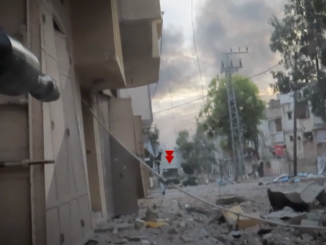
Yemen’s Ansarallah recently declared that they had joined the battle against Israel, which began with the Hamas-led offensive on October 7.
Recently propelled into the international spotlight, after declaring war on Israel in support of Gaza, Ansarallah remain a group shrouded in mystery to Western audiences and have previously only ever been portrayed as Iranian proxies at war with their Saudi neighbors.
So who are Ansarallah and how did they become the ruling party in Yemen?
Ansarallah’s Origins
Ansarallah’s origins can be traced back to the early 1990’s, in the northern Saada Governorate of Yemen.
The movement initially emerged as what can accurately be described as a rebel group, led by religious, military, and political leader Hussein al-Houthi.
At first, the group emerged as an opponent of the Yemeni government; led by Ali Abdullah Saleh. After Hussein’s murder, at the hands of Yemen’s army in 2004, his brother, Abdul-Malik al-Houthi took on the position as the movement’s leader.
On September 21, 2014, Ansarallah’s forces entered the Yemeni Capital, Sanaa, as part of a popular revolution against the government that was led by the country’s President Abdrabbuh Mansour Hadi.
By January of 2015, President Hadi had resigned and former Yemeni leader, Ali Abdullah Saleh, along with the majority of the country’s army, had sided with the Ansarallah movement.
Although Ansarallah had formed a Revolutionary Committee and seemed destined to become a real governing force, which it has now become, Saudi Arabia decided to launch a regime-change war that sought to reinstate Abdrabbuh Mansour Hadi as the nation’s leader by force.
YEMENI ARMED FORCES (ANSAR ALLAH): We targeted two Israeli ships at Bab al-Mandab, namely the ship "Unity Explorer" and the ship "Number Nine,"
We will continue to prevent Israeli ships from navigating until the aggression against Gaza stops.
FOLLOW OUR LIVE BLOG:… pic.twitter.com/zu1KQWL2i3
— The Palestine Chronicle (@PalestineChron) December 3, 2023
Ansarallah-Led Revolution
Saudi Arabia, which possesses considerable influence amongst Yemen’s tribes, is considered by many to have been Yemen’s sworn enemy since 1922 when thousands of barefooted Yemeni pilgrims were murdered by clansmen under the control of Saudi Arabia’s ruling family.
Its blockade on Yemen and invasion, which relied on a coalition of Arab countries backed by the United States and Israel, has resulted in a resounding failure to undo the Ansarallah-led revolution.
In fact, the careful handling of tribal affairs, the establishment of a regularly functioning government, and its control over some 80% of Yemen’s population have proven the success of Ansarallah.
The movement, which was originally a rebel movement of Zaydi-Shia Muslims, has now transformed into a formidable military, social and political party.
It is often referred to as the “Houthi Rebels” and as an “Iranian proxy group”, in attempts to undermine the movement’s credibility.
The United Nations has yet to accept the Ansarallah government as the legitimate governing authority in the country, in favor of supporting the Presidential Leadership Council that was created in Riyadh, Saudi Arabia, in 2022.
Until the formation of the Saudi-backed council, the UN recognized Abdrabbuah Mansour Hadi as Yemen’s legitimate President, despite the fact that he resigned from the position and was not in control of the capital, the majority of the country’s population or the majority of Yemen’s Armed Forces.
The Yemeni Naval Forces captured an Israeli-linked ship in the Red Sea, the Lebanese Al Mayadeen news network reported on Sunday, citing sources familiar with the matter.https://t.co/yGBD8jYjW3 pic.twitter.com/92sYaBLMeW
— The Palestine Chronicle (@PalestineChron) November 19, 2023
Axis of Resistance
Ansarallah recently declared that they had joined the battle against Israel, which began with the Hamas-led offensive on October 7.
The movement began participating on the side of the Palestinian Resistance groups, in what it said was a response to popular calls from Yemen’s public to take action against Israel for its crimes in Gaza.
They fired dozens of drones and ballistic missiles towards areas in the south of occupied Palestine, then proceeded to announce that they would go after Israeli flagged, operated and owned ships in the Red Sea.
Ansarallah belong to what is known as the ‘Axis of Resistance’, led by the Islamic Republic of Iran’s Islamic Revolutionary Guard Corps (IRGC), the other members of this axis include the Palestinian, Lebanese and Iraqi groups that resist Western and Israeli occupation of their territories.
Yemen’s Ansarallah also, like their regional allies, seek to liberate their country from foreign occupation. They also seek to directly combate the United States of America and Israel, viewing both as its primary opposition and as the true enemies of the people inhabiting the Arabian Peninsula, along with the wider West Asia region.
Although the movement clearly has Islamic undertones and was rooted in the Houthi tribe, its approach changed overtime and managed to reach a mass base of support from different groups throughout Yemen.
It is widely acknowledged that Ansarallah was a direct product of foreign intervention, a characteristic it shares with the likes of Lebanese Hezbollah and other resistance organizations.
The Yemeni Armed Forces (Houthis) released a video showing their daring operation in the Red Sea on November 19. The video demonstrates how Yemeni fighters took over an Israeli-owned ship, before hauling it to an unspecified Yemeni port. pic.twitter.com/SFHUaREB6m
— The Palestine Chronicle (@PalestineChron) November 20, 2023
(The Palestine Chronicle)

– Robert Inlakesh is a journalist, writer, and documentary filmmaker. He focuses on the Middle East, specializing in Palestine. He contributed this article to The Palestine Chronicle.








The Zionist regime worldwide and their evil accomplices,are already on a journey of no-return. They and their stupid vision of ‘greater Isra hell’s will perish, God-willing in the hands of the resistant warriors